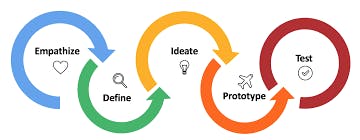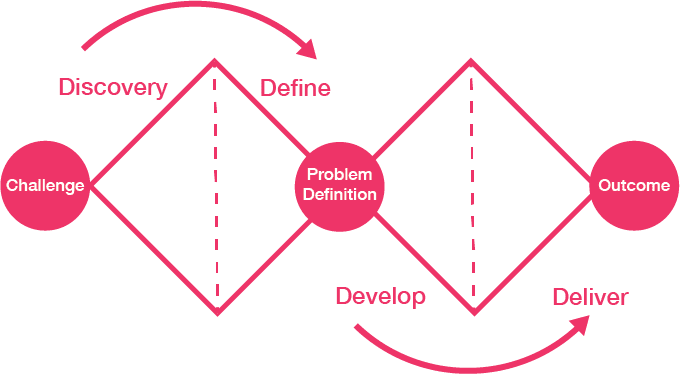Introduction
In the previous article, we outlined the major differences between UI and UX design. Several people admitted to not being able to distinguish between the two. This article today dives deeper into UX design. It outlines the key frameworks to use when designing for a great user experience.
Just as Google maps shows the shortest route possible to beat the traffic jam, a UX framework outlines the whole idea from the start of designing to the end real-life results.

There are five key design frameworks in UX that can be employed, namely:
- User-centered design
- 5 elements of design
- Design thinking
- Lean design
- Double diamond.
Each of these frameworks is suitable for use in different circumstances.
For a successful design, outline the project deliverables, pick a framework or two to work with, and build inclusive designs based on the chosen framework(s).
Let's explore them further!
User-Centered Design
As the name describes, this design focuses on the user. It puts the user as the primary focus taking into account their insights, emotions, and stories about them. User-centered design has four steps:
Understand - The first step is to conduct user research to gather how the user experiences or perceives a product.
Specify- Based on the research and deep understanding, take note of specific user needs that require to be fulfilled. Narrow down to the least important end-user problem to solve, to focus on the most important ones.
Design- In this step, come up with design solutions to address the user's problem. Focus on ideas of what the product will look like, then build it.
Evaluate- The final step is to compare the design against the users' needs to ensure it meets the requirements. The main question to ask is, does the design offer an effective solution to the user's problem? One way to find out is to conduct tests of the product with people iteratively, then improve the previous product version.
5 Elements of UX Design
The 5 elements of the UX design framework assist designers in turning an idea into a working product. As the name suggests, it involves five elements; Strategy, Scope, Structure, Skeleton, and Surface.
The framework runs from the bottom layer, which is the strategy, to the top layer, the surface. Each subsequent layer is dependent on the previous layer, as discussed below.
Strategy - The bottom layer. Defines the user's goals and needs
Scope - Fourth layer; Identify the design you want to build. What features and content will the product contain?
Structure - Third layer; Organize the product design for user interactivity.
Skeleton - Second layer. Think of this as a layout that details how the design works, without the user knowing the inner workings, similar to our bones underneath the skin.
Surface - The topmost layer. It describes how the product appears. This is what will attract the user to a product.
Design Thinking
While both user-centered design and design thinking framework focus on the user, the design thinking framework ensures that the solutions designed to address the user problems are functional and affordable. This framework consists of five main steps namely; empathize, define, ideate, prototype, and test.

Empathize - This term refers to an act of understanding and sharing someone's feelings. As defined, empathizing involves researching what the users need, in addition to learning their emotions and thought patterns. It can be done through conducting interviews, surveys, or making an observation of the user.
Define - After understanding the user's emotions and thoughts, the next step is to come up with a clear problem statement. The problem statement will outline the most important user problem that should be addressed. This statement will guide the team in having a clear goal while designing the product.
Ideate - Next step after problem definition is to brainstorm the possible solutions to the user problem. The goal is to come up with as many ideas as possible. This way the team can come up with innovative solutions - quantity over quality.
Prototype- From the many solution ideas gathered, it is time to narrow down on a few ideas that can be prototyped.
Test- Final step is to test the prototype with users. Through testing, the team collects feedback on the product before it is built, and makes improvements based on the users' feedback.
Lean UX
In bodybuilding, the state of being lean mostly refers to containing little fat, sometimes termed as thin. Likewise, the Lean UX framework pivots toward reducing wasted time and resources while producing a usable product instantaneously. Similar to other design frameworks, it is iterative. The product is continually revised and improved while acquiring stakeholders' feedback.
This framework involves three main steps:
Think- Similar to other design frameworks, it starts with conducting user research on the problems encountered and then brainstorming on ways to solve them with the design. The deliverable of this step is a clear picture of the product user and how helpful and functional the product will be to them.
Make- Next step is to draw sketches, and create wireframes and prototypes for the product. A Minimum Viable Product (MVP), which is a simple prototype can be designed to test the product with the target audience. This process involves a lot of back and forth as the user feedback gathered is used to improve the product to better suit the users' needs.
Check- Lastly, collect feedback on the final product from the stakeholders. Make the needed adjustments to your designs, and iteratively repeat the steps as needed, until the desired product is achieved.
The Lean UX process encourages productivity and collaboration. The team is usually made up of cross-functional members working together.
Double Diamond
The double diamond framework is among the traditional UX design processes. It takes four steps which are divided into two main phases: Research and Design. The research phase covers the discovery and definition of the user problem, while the design phase focuses on designing the solutions and product delivery. To further expound on the steps;

Discover the problem- Carry out user research to collect information on potential user problems.
Define the problem - Filter the data, and pinpoint one main problem to focus on for product development.
Develop solutions to the problem - Design your solution continually. This step can involve creating wireframes and prototypes for the product
Deliver the product - Review the product designed and test it with users as you prepare it for release.
Similar to most design frameworks, Double Diamond is both iterative and non-linear. This framework involves sprints that are dependent on each other. With each sprint, the team gains more insights on ways to improve the product design, and the process continues iteratively until satisfied. Think of it like a student submitting several drafts to the professor. With each time, new improvements are made to the draft until the student can submit a final draft for grading.
Double Diamond encourages teamwork in an organization as much as it focuses on design.
Final Thoughts
Every framework has its own unique capabilities, but all revolve around the same iterative design process; user research, brainstorming ideas, design, then test. Choose a framework or two and try it out in your designs.
Let's connect and share with me which framework works best for you. I'd love to know.
Thank you for reading!
